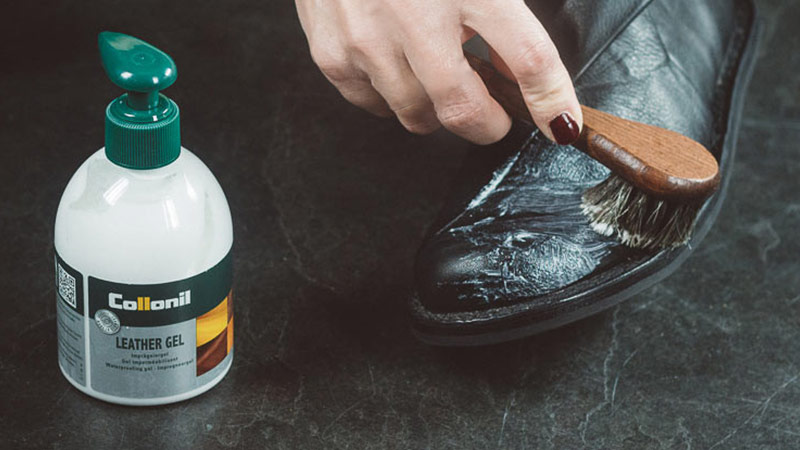How to Use Collonil Leather Gel to Condition Your Leather
The Collonil Leather Gel is a high-quality waterproofing gel that helps to restore, rejuvenate and protect your leather from the elements. It’s therefore one of the best gels for leather products that are often exposed to rain and moisture. Make sure to check out our comprehensive Collonil Leather Gel Review.
In order to benefit from its properties, it’s important to apply it to your product correctly. This will allow the gel to work its full potential and not only waterproof, but also nourish and color-activate your leather.
Here are the instructions on how to use the Collonil Leather Gel:
- Wipe Leather with a Damp Cloth
- Apply Collonil Leather Gel Evenly
- Buff Leather Using a Soft Brush
- Remove Excess Gel from Leather
1. Wipe Leather with a Damp Cloth
The first thing that you’ll need to do is remove any dirt from the surface of the leather. This is important, as it helps to create a clean layer allowing the collonil gel to absorb into the leather and create a waterproof layer.
This is best achieved using a damp cloth. Simply run it over the leather and apply minimal pressure. Remove all access dirt until the leather is clean. Make sure that the cloth is damp and not wet, as you don’t want to saturate the leather.
Next, inspect your leather thoroughly and ensure that it’s entirely clean. This will help you get the most out of the Collonil Leather Gel. It’s also important to let your leather dry before you start applying any product. Once dry, you’re ready to go to the next step.
2. Apply Collonil Leather Gel Evenly
You’ll now want to apply some Collonil Leather Gel on your product. This will add moisture and nutrients that will help to waterproof, nourish and maintain it.
When you apply the gel, ensure that you don’t use too much. Now, evenly distribute the gel across the leather so that it creates a thin coating across the entire surface. This is best achieved using a fine cloth.
If you’re unsure if the Collonil Leather Gel is suitable or are using it for the very first time, you can simply apply it onto a concealed area to test it.
3. Buff Leather Using a Soft Brush
As an additional step, you can use a fine brush to gently stroke the gel into the leather. It’s best to use circular or horizontal strokes for this. During this process you may notice light lathering, which is completely normal.
For this, you may use a regular brush or even a makeup or shaving brush. Just ensure that the bristles are made of either fine natural or synthetic hair. Horsehair brushes are great for this as they have extremely soft bristles and are known to be gentle on leather.
Make sure that you brush across the entire surface evenly and only apply gentle and soft strokes throughout the brushing process.
4. Remove Excess Gel from Leather
After buffing your leather with a brush, a thin layer of lather should still be visible. You should remove any excess gel from your leather using a dry cloth. Avoid using the same cloth you used removing the dirt off your leather in the first step. Alternatively, thoroughly clean the cloth first and let it dry.
It’s also extremely important to ensure that the cloth is dry when doing this, as you won’t want to introduce more water into your leather. If too much water gets into the leather once it dries, it extracts many of the oils, as well as the protective coating of the Collonil Leather Gel.
Use a dry cloth instead and gently remove the lathering layer. Remove any excess gel from the entire surface. For this, feel free to use different parts of the cloth.
This should give your leather the optimal coating to repel dirt, offer water protection and leave behind a polished and gleaming surface.
Things to Keep in Mind When Using the Collonil Leather Gel
When using the Collonil Leather Gel on your leather products there are a few things you may want to keep in mind.
- Don’t use too much product – using too much product will not only result in wastages, but it can easily lead to saturation causing the leather pores to clog – especially important when it comes to full-grain leather.
- Avoid using a wet cloth – using a wet cloth instead of a damp one may cause oil extraction from the leather, which should be avoided at all times.
- Let it fully dry before applying gel – applying the Collonil Leather Gel before the leather is dry can make it less effective as water is introduced into the leather. Also ensure that you let your leather naturally dry and avoid direct sunlight.

About Gerrit
Co-Founder, Researcher & Writer At Leatherskill
I’m a leather enthusiast who spends most of his free time crafting, researching, and writing about the many facets of this versatile material. Thanks for reading!

